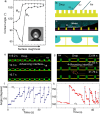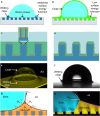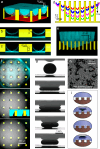Drop Friction and Failure on Superhydrophobic and Slippery Surfaces
- PMID: 40367354
- PMCID: PMC12120990
- DOI: 10.1021/acsnano.5c01142
Drop Friction and Failure on Superhydrophobic and Slippery Surfaces
Abstract
The mobility of drops on a surface influences how much water and energy is required to clean the surface. By controlling drop mobility, it is possible to promote or reduce fogging, icing, and fouling. Superhydrophobic and slippery liquid-infused surfaces both display high drop mobility despite being 'lubricated' by fluids having very different viscosities. Superhydrophobic surfaces rely on micro- and/or nanoscale textures to trap air pockets beneath drops, minimizing solid-liquid contact. In contrast, on liquid-infused surfaces, these solid textures are filled with an immiscible liquid lubricant. Over the past few years, innovations in experimental and computational methods have provided detailed new insights into the static and dynamic wetting properties of drops on these surfaces. In this review, we describe the criteria needed to obtain stable wetting states with low drop friction and high mobility on both surfaces, and discuss the mechanisms that have been proposed to explain the origins of friction on each surface. Drops can collapse from the low-friction Cassie state to the high-friction Wenzel state on both surfaces, but the transition follows different pathways: on liquid-infused surfaces, the wetting ridge near the drop edge plays a central role in triggering collapse, a phenomenon not observed on superhydrophobic surfaces. This review emphasizes that a liquid-infused surface cannot be simply viewed as a superhydrophobic surface with the air pockets replaced by lubricant. The wetting ridge surrounding drops on liquid-infused surfaces significantly alters most of the drop's properties, including macroscopic shape, friction mechanisms, and the mechanism of collapse to a Wenzel state.
Keywords: adhesion; capillarity; drops; friction; interfacial phenomena; lubrication; roughness; surface cleaning; wetting.
Figures












Similar articles
-
Direct observation of drops on slippery lubricant-infused surfaces.Soft Matter. 2015 Oct 14;11(38):7617-26. doi: 10.1039/c5sm01809a. Soft Matter. 2015. PMID: 26291621
-
Slippery Wenzel State.ACS Nano. 2015 Sep 22;9(9):9260-7. doi: 10.1021/acsnano.5b04151. Epub 2015 Aug 28. ACS Nano. 2015. PMID: 26302154
-
Friction force-based measurements for simultaneous determination of the wetting properties and stability of superhydrophobic surfaces.J Colloid Interface Sci. 2023 Oct 15;648:161-168. doi: 10.1016/j.jcis.2023.05.161. Epub 2023 May 30. J Colloid Interface Sci. 2023. PMID: 37301141
-
Lotus Effect and Friction: Does Nonsticky Mean Slippery?Biomimetics (Basel). 2020 Jun 12;5(2):28. doi: 10.3390/biomimetics5020028. Biomimetics (Basel). 2020. PMID: 32545628 Free PMC article. Review.
-
Wetting on silicone surfaces.Soft Matter. 2024 Jul 10;20(27):5273-5295. doi: 10.1039/d4sm00346b. Soft Matter. 2024. PMID: 38952198 Review.
References
-
- de Gennes, P.-G. ; Brochard-Wyart, F. ; Quéré, D. . Capillarity and Wetting Phenomena, 1st ed.; Springer: New York, NY, 2004. 10.1007/978-0-387-21656-0. - DOI
-
- Bormashenko, E. Yu. Wetting of Real Surfaces; De Gruyter: Berlin, Boston, 2018. 10.1515/9783110583144. - DOI
-
- Butt, H.-J. ; Kappl, M. . Surface and Interfacial Forces, 2nd ed.; Wiley-VCH, 2018.
-
- Wagner T., Neinhuis C., Barthlott W.. Wettability and Contaminability of Insect Wings as a Function of Their Surface Sculptures. Acta Zool. 1996;77:213–225. doi: 10.1111/j.1463-6395.1996.tb01265.x. - DOI
Publication types
LinkOut - more resources
Full Text Sources
Miscellaneous

